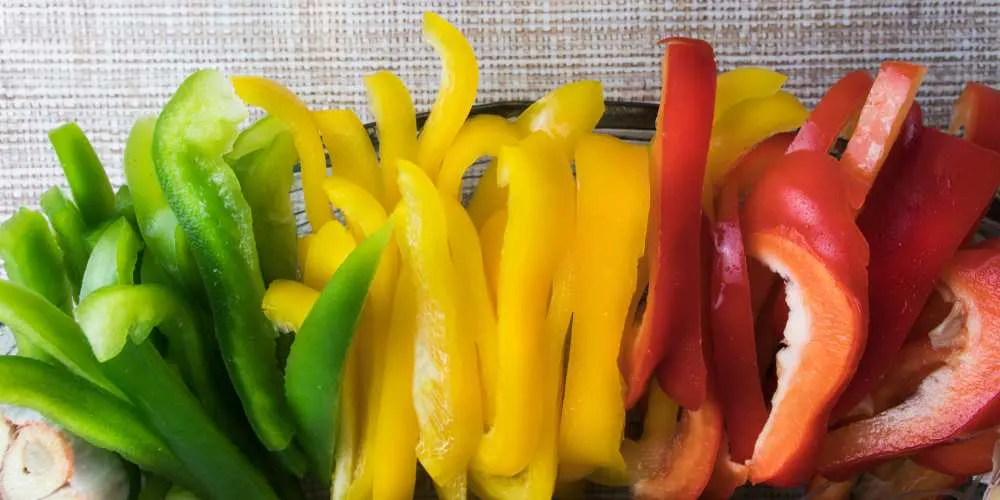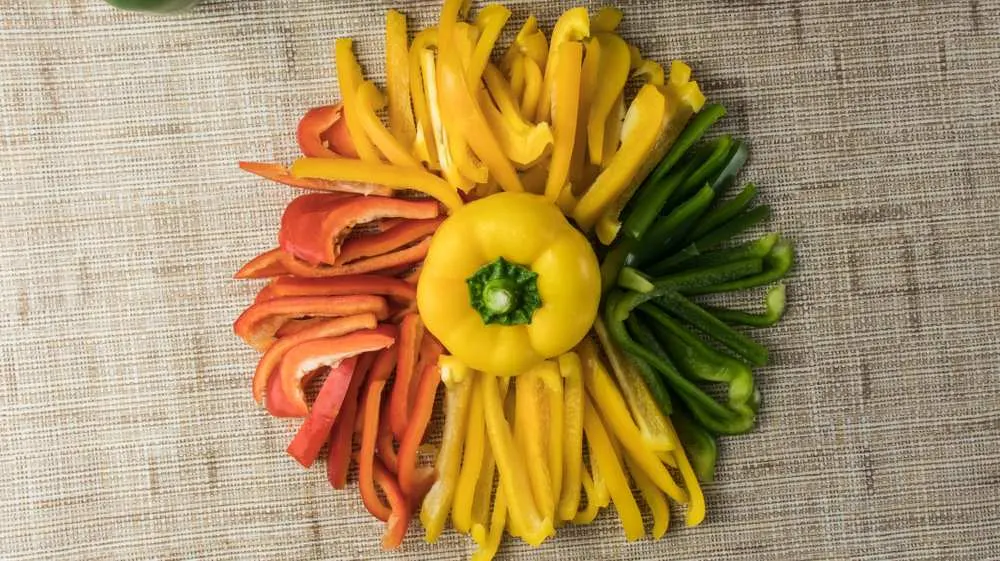It goes without saying that the best food for your pup is dog food – it’s balanced out, and it gives your dog all the necessary nutrients.
Of course, your dog doesn’t care about that stuff. So, whenever you’re in the kitchen, your pet will stand by your side, and look at you with those giant cartoon-like eyes. At some point, your dog will start to beg for some food, even if it ate like, an hour ago.
You ignore the begging, but today, a whole bell pepper fell to the floor. And sure enough, your dog was there to devour it before you could even react.
Now, you’re worried about the dog’s health. Can dogs eat bell peppers? Can they get sick from eating them? If you need the answers to these questions, continue reading!

Can Dogs Eat Bell Peppers?
Let’s start by saying yes, dogs can eat bell peppers. They have a nutritional value to your dog’s health, so it’s even good for dogs to eat bell peppers.
Dogs are omnivores in nature, so they can eat fruits and vegetables along with meat. They do need more meat in their diet than vegetables, but they can enjoy veggies just like us!
Your canine pet can’t digest some vegetables, and some can even make it sick. On the other hand, you can give a bell pepper to your dog without worry if you serve it properly.
It’s important to introduce new food to your dog before you start giving it on the regular. Dogs can have food allergies, too. So, start slow to ensure your dog is safe eating bell peppers!

Introducing Bell Peppers To Your Dog’s Diet
When you decide you want to add some new food to your pet’s diet, you must do it gradually. Your pet may be opposed to the new food if you serve it a meal based on it.
So, without a rush, add a tiny amount of bell pepper to the regular meal, and see the reaction. If your dog likes it, the food bowl will be empty in a minute or so. Check out our article to find out can dogs eat cantaloupe.
Each time, add a little more than you did last time and watch the dog closely afterward. If your dog behaves unusually in any way, discontinue the use.
When preparing a meal for your dog, do it separately from making a meal for your family. Some spices complement meals for humans, but they can spoil your pup’s stomach!
Serving The Bell Peppers To Your Dog
You must give your dog new food properly. First, chop the pepper into small pieces – it will be easier for your dog to digest tiny bits rather than full slices.
When dicing the pepper, remove the seeds and the stem. Seeds can be difficult for the dog to digest, so it’s best to remove them altogether.
Next – you can either add raw or cooked bell peppers to the bowl. However, we strongly recommend that you cook it first. High-fiber foods like peppers can be tough on your pup’s digestive system – it can result in vomiting or diarrhea. Cooking high-fiber foods (like bell pepper) makes them easier to pass.
You can cook it with vegetable oil, steam it, or make bell pepper puree. Either way, your pet will be happy and eat it up in a second!
Bell Peppers To Avoid
Some bell peppers are great for dogs. For example, sweet bell peppers are perfectly safe, but hot peppers are not.
Make sure your puppy gets nowhere near chili peppers. If the dog eats a cayenne pepper, it will upset its stomach and probably result in diarrhea. If that does happen, give your dog medicine to soothe its tummy, and perhaps some pureed pumpkin. If you’re already panicking – relax a little – it’s not lethal for a dog to eat chili peppers. But, the dog won’t have a good time, either!

How Much Bell Peppers Can A Dog Eat?
Adding bell peppers to your pet’s diet is healthy if you add the correct amount to the meal. Eating too little will not give enough benefits to your pet’s health, and too much can make it ill. So, what is the correct amount?
| Small dog breeds | Medium dog breeds | Large dog breeds |
|---|---|---|
| One medium-sized slice | Two medium-sized slices | Up to half of a bell pepper |
Your pet can eat bell peppers often, but don’t make it a regular food. Dogs need a variety of vitamins and minerals in their diet, so it’s essential to rotate foods every once in a while.
Giving Bell Peppers As A Treat
If your pet enjoys snacking on bell peppers, they can be an excellent option for a treat. Each portion of treats should be smaller than a medium-sized slice.
When dosing the treat size, remember the 10% rule. The 10% rule means that the treats should never go over 10% of the dog’s daily food intake.

Benefits Of Eating Bell Peppers
Your dog needs a variety of nutrients – vitamins and minerals, to live a long and happy life. Unlike humans, they do not need a lot of fruit and veggies for their health. For dogs, a little goes a long way.
Sweet peppers are a great source of fiber. Fiber is vital for maintaining a regular digestive system.
So, bell peppers are a nutrient-rich food for humans, as well as dogs. Dogs can certainly benefit from a high amount of Vitamin A, C, and E, found in peppers. There are other vitamins and minerals found in bell peppers, so let’s see what they are!
Nutritional value per 1 cup of diced bell pepper:
| Calories | 46.2 kcal |
| Protein | 1.5g |
| Carbohydrates | 9.4g |
| Dietary fiber | 3.1g |
| Sugar | 6.3g |
| Vitamin A | 4666IU |
| Vitamin C | 190mg |
| Vitamin E | 2.4mg |
| Vitamin K | 7.3mcg |
| Vitamin B6 | 0.4mg |
| Folate | 68.5mcg |
| Calcium | 10.4mg |
| Iron | 0.6mg |
| Magnesium | 17.9mg |
| Potassium | 314mg |
Bell peppers offer nourishment for your dog’s overall health. The sweet pepper has a 92% water content – so it’s great to give your dog peppers on a hot day, so it stays hydrated.
Also, let’s check out the benefits of dogs eating bell peppers:
| Helps dog maintain good vision | Vitamin A and beta carotene found in peppers are proven to preserve vision |
| Boosts immunity | High amounts of Vitamin C boost the immune system of mammals |
| Keeping the nervous system healthy | Bell peppers are rich in Vitamin B6 which is crucial for a functional nervous system |
| Keeping the skin and fur healthy and shiny | Vitamin E regenerates the skin and the hair follicles |
Also, red bell peppers pack a little more Vitamin C and beta carotene than yellow and green peppers. All colors are safe and tasty, but the red ones are a little more alimental for your dog.
Furthermore, make sure to cook your dog meals with ripe bell peppers. The riper they are, the richer they are nutrient-wise!

What If Your Dog Eats Too Much Bell Pepper?
We’ve discussed the amounts of bell pepper that are safe for dogs. But, what happens when the dog eats too much?
Maybe the dog dug through the trash, or some bell peppers rolled off the counter – either way, your pet was there to gobble all of it. Now, you’re sick with worry about what will happen to the pet.
Usually, the worst that can happen is a little vomiting or diarrhea. A fiber-dense food like a sweet pepper can upset your puppy’s tummy because it’s hard to digest. So, some tummy woes are to be expected, but nothing serious.
If the tummy woes continue for longer than a day, it’s time to trip to the veterinarian!

Conclusion
We’ve concluded that dogs can eat bell peppers. Moreover, bell peppers pack a punch of vitamins that are principal for your dog’s wellbeing.
It’s important to note once again that cooking sweet peppers are a better option than serving them raw. Your dog is less likely to experience indigestion that way. Always discourage your dog from eating hot peppers!
Introduce bell peppers according to our guidelines, and your canine will learn to love this wholesome treat. Does it using our table, and you’re good to go!
It should go without saying, but always keep an eye on your dog after giving it some new food. Some dogs will develop a reaction to the new food, so if you notice strange behavior, stop using that food for making meals.
Therefore, bell peppers can be fun for your dog! With some precautions, your dog will grow to love meals with sweet peppers!
Learn More: What Can Dogs Eat? A Comprehensive List Of Dog-safe Foods

